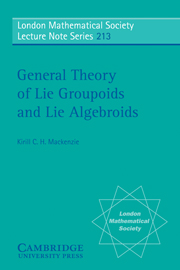Book contents
- Frontmatter
- Contents
- Prologue
- Introduction
- Preface
- TERMINOLOGY AND NOTATION
- ACKNOWLEDGEMENTS
- PART ONE THE GENERAL THEORY
- PART TWO THE TRANSITIVE THEORY
- PART THREE THE POISSON AND SYMPLECTIC THEORIES
- 9 Double Vector Bundles
- 10 Poisson Structures and Lie Algebroids
- 11 Poisson and Symplecfie Groupoids
- 12 Lie Bialgebroids
- Appendix
- Bibliography
- Index
11 - Poisson and Symplecfie Groupoids
from PART THREE - THE POISSON AND SYMPLECTIC THEORIES
Published online by Cambridge University Press: 05 April 2013
- Frontmatter
- Contents
- Prologue
- Introduction
- Preface
- TERMINOLOGY AND NOTATION
- ACKNOWLEDGEMENTS
- PART ONE THE GENERAL THEORY
- PART TWO THE TRANSITIVE THEORY
- PART THREE THE POISSON AND SYMPLECTIC THEORIES
- 9 Double Vector Bundles
- 10 Poisson Structures and Lie Algebroids
- 11 Poisson and Symplecfie Groupoids
- 12 Lie Bialgebroids
- Appendix
- Bibliography
- Index
Summary
Poisson groupoids provide a simultaneous generalization of Poisson Lie groups and symplectic groupoids. Both theories have considerable literatures of their own, and it is not the intention here to develop their individual features beyond the basic properties. The purpose of this chapter is to show how the general features of Poisson groupoids — and thus of the two main special cases — may be deduced by a systematic application of what one might call ‘diagrammatic’ methods to cotangent structures.
The way in which the Poisson structure and the group structure of a Poisson Lie group interact is fundamentally different to the relationship between a group structure and, say, the smooth structure in a Lie group. Immediate consequences of the definition of a Lie group are that right and left translations are smooth, and inversion is smooth, and there are many mixed algebraic–topological concepts which behave in a similar way. A Poisson Lie group is often defined as a Lie group with a Poisson structure for which the multiplication is a Poisson map, but despite the apparently standard nature of this compatibility condition, inversion in a Poisson Lie group is not Poisson but antiPoisson, and right and left translations are generally neither Poisson nor antiPoisson. In fact the compatibility condition is not as standard as it appears, since a Poisson structure is not, strictly speaking, defined on the manifold itself, but on the module of smooth functions, or 1–forms.
- Type
- Chapter
- Information
- General Theory of Lie Groupoids and Lie Algebroids , pp. 408 - 445Publisher: Cambridge University PressPrint publication year: 2005

